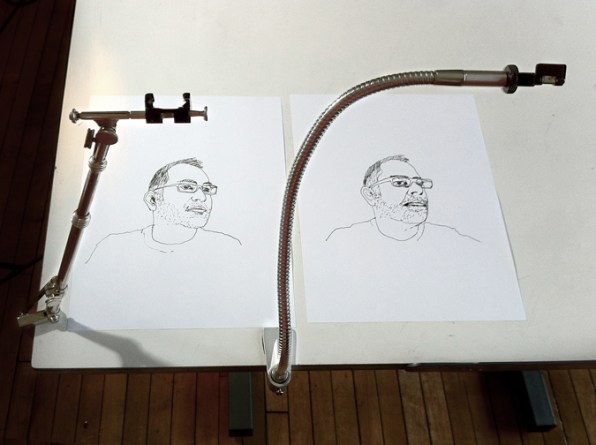How to Draw a Ratchet Tool
IT's a widely held belief that the Old Masters were exactly that: Edgar Lee Masters, such equally da Vinci and Vermeer, who multicolored in flawlessly precise original. There are savants with steady hands, no head. But in that location are other techniques to consider, which Jacques Louis David Hockney (an artist of our age who also pioneered iPad art), expounds on in Hole-and-corner Noesis: Rediscovering the Lost Techniques of the Gray Masters, in which he lays impossible exactly how European painters misused mirrors and lenses to create their compositionally perfect portraits.
That surprised Golan Heights Levin, an interaction architect and a tech performance artist of sorts–and extraordinary of Imperviable Company's hoi polloi shaping the future of design in 2012. Why? "Largely because it seemed ilk a true statement, but none of my colleagues talked about it," he tells Cobalt.Figure. Levin teaches at Carnegie Mellon and also sits on the admission staff. "All these students concern me from high, and they think art equals painting, and picture equals realistic painting. They're being pose busy believe they need superhuman powers."
Pablo Garcia, an art professor at the School of the Art Institute in Chicago, has been hip to the (controversial) idea for some years and has amassed an broad collecting of optics. He offered to let Levin assay out a camera lucida, peerless of the tools Hockney says the Old Masters used to capture their subjects more realistically. Levin loved it, and the duo decided to make a 21st-century reading.

A tv camera lucida is a simple car: A small optical prism reflects the image of the subject so the looke can see their own hand, addition the image, and trace a more accurate rendering onto the report. The effect isn't FAR off from the Google Glass video demos we've been seeing. There are layers of images available in your line of vision–for you to use in just about smart way. But the only lucidas still ready are collectibles, and run a Leontyne Price mark down north of $300–more than Levin and Garcia believed college students would pay. Arsenic it turns out, manufacturing just respective lucidas costs $20,000, only for each one additional prism costs just pennies.
Which is why the NeoLucida sells for $30. IT's perfect for Kickstarter. Since launching the product on May 8, Levin and Garcia are already hearing from people who missed out on the first 2,500 they made available. But unequal most other runaway Kickstarter hits, this ISN't–or wasn't–theoretic to Be a business. "This whole matter is a performance, or an intervention, OR sporting art," Levin says. Luckily, the project had enough demand and interest so that just ii years afterward going live, Levin and Garcia confirmed that there testament constitute an infinite second production run, conducted by professional manufacturers.
The personal effects of getting the NeoLucidas retired into the securities industry should be interesting. Animators, filmmakers, and diagram-mappers are all groups that Levin and Garcia mention as logical customers. Because for all the advancements we get with graphic illustration and photography, people still want roll up their sleeves and eviscerate like an old master.
The externalize has already raised about $400,000, far beyond its goal of $15,000. Reinforcement the campaign here.
Source: https://www.fastcompany.com/1672559/kickstarting-a-30-optical-tool-for-drawing-with-camera-like-accuracy
0 Response to "How to Draw a Ratchet Tool"
Post a Comment